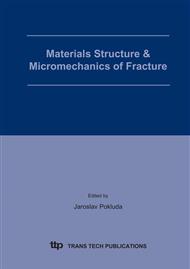p.55
p.63
p.71
p.77
p.83
p.89
p.95
p.103
p.109
Effect of Processing Route on Microstructure and Mechanical Behaviour of Ultrafine Grained Metals Processed by Severe Plastic Deformation
Abstract:
Aluminum-based alloys containing quasicrystalline particles of 50 – 600 nm in diameter as a reinforcing phase were produced in the form of powder or ribbons by water atomization or melt spinning techniques, respectively. Rods were compacted from powders and some ribbons by severe plastic deformation without sintering. Structure and mechanical behavior of alloys are discussed.
Info:
Periodical:
Pages:
83-88
Citation:
Online since:
April 2005
Authors:
Price:
Сopyright:
© 2005 Trans Tech Publications Ltd. All Rights Reserved
Share:
Citation:


